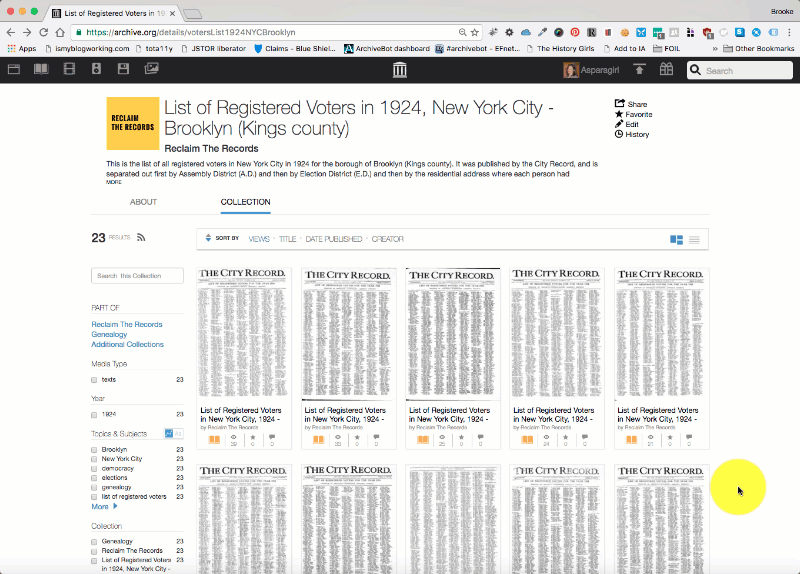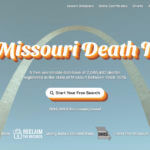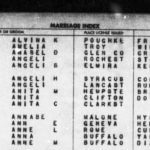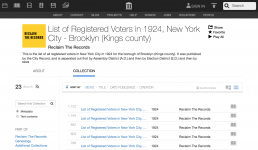 The 1924 New York City list of registered voters is now online
The 1924 New York City list of registered voters is now online
You can now browse the images of this record set on the Internet Archive:
Brooklyn (Kings county) · The Bronx (Bronx county) · Manhattan (New York county) · Queens (Queens county) · Staten Island (Richmond county)
Hello again from Reclaim The Records, your friendly neighborhood records access activists. In honor of the upcoming election, this month we’re bringing you a brand new voter-related genealogical record set, for free public use.
It’s the second-ever publication (but the first-ever digital and online publication) of the List of Registered Voters for New York City for the year 1924! It’s hundreds of thousands of names, perhaps over a million — we don’t know the exact number yet, but keep reading for some Nate Silver 538-style statistics and estimates.
These records were available in paper format ninety-two years ago, then stored in shrinkwrap and locked away in government warehouses for years. But now thanks to Reclaim The Records, the New York City Municipal Archives, and our first-ever joint project with an individual genealogist, they’re finally online!
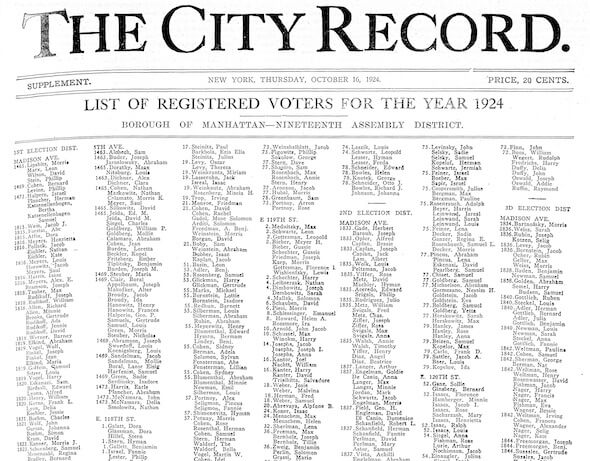
This list of names is exactly what it sounds like, a list of everyone in New York City who was legally registered to vote in the 1924 election. It was originally compiled by the New York City Board of Elections and printed in the City Record, a daily government publication. That means that this kind of registered voters list isn’t under copyright and is potentially available under state Freedom of Information laws — which is exactly the kind of thing we like to acquire and publish.
The list is broken down by the five boroughs (counties) of New York City, and then each borough is broken down by their Assembly Districts. Here are the links to these newly online publications at the Internet Archive:
- Bronx – 8 Assembly Districts in 1924
- Brooklyn – 17 Assembly Districts in 1924
- Manhattan – 23 Assembly Districts in 1924
- Queens – 6 Assembly Districts in 1924
- Staten Island – 2 Assembly Districts in 1924
And then within each of those Assembly Districts (A.D.), the list is further broken down into Election Districts (E.D.) and then by street addresses.
Each one of these new documents is a series of high quality images or PDF’s that you can flip through like a book, zoom in close, or even download for offline use.
And here’s some more cool news: while there isn’t a formally transcribed database of these names yet, just a series of images, the original source was typeset and the digital photographs were very clear, so the Internet Archive was able to automatically OCR all of the names on the pages! That means that even without a transcription project being organized, you can already do a full-text “Search Inside This Book” for a particular name or street address you’re seeking in these files! Here’s an animated GIF showing how that would work:
Now, this automated OCR (image-to-text transcription) that the Internet Archive ran on the records is not perfect at all. Lots of o’s and a’s and e’s were mistaken for one another, and some other letters get switched too. But it’s a pretty good start and will help you find your way around the data.
The better way to find a name on this list is to look someone up in the 1925 New York State Census, which was held less than a year after this list was compiled, and note the borough, A.D., E.D., and address on a person’s census listing, and then go look up that same location information in this new 1924 list. Of course, that assumes that someone hadn’t changed addresses between their voter registration in late 1924 and the state census in early 1925, but probably not too many people did that.
Where did this information come from?
In early 2016, a New York and Florida based genealogist named Phyllis Kramer approached Reclaim The Records with an idea. Phyllis had heard about our success in obtaining records from the New York City Municipal Archives using state Freedom of Information laws. She wanted to know if the same FOIL process could be used to obtain copies of old voting and election-related materials. We figured, okay, let’s try that and see how it goes.
After some discussion, we picked 1924 as our target year. Our reasoning was that it was a presidential election year, so voter registration rates were likely to be higher, and there would probably be more names on the list. Furthermore, 1924 was shortly after the passage of the Nineteenth Amendment and we could finally start seeing female relatives’ names on the rolls. And World War I would have ended, so the men fighting overseas would have been back home to appear on the rolls, too. Finally, a significant percentage of the huge turn-of-the-century immigration wave to New York City would have completed the naturalization process by 1924, allowing them to potentially show up in the voter rolls too. It seemed like 1924 could be a good and fruitful year of data for genealogical research.
And so, Reclaim The Records’ first-ever joint project with a genealogist was undertaken to obtain the first public copy of this list in ninety-two years. We reached out to the Municipal Archives, and were told that we would not need to file a FOIL request for this project, we could just handle everything through e-mail this time, which was welcome news. We commissioned the first-ever digital imaging of the 1924 list from where it had sat in storage, after having been moved from the New York City Board of Elections’ warehouse. The Municipal Archives hired a photographer for the lists, and a few months later they sent us the beautiful new digital images (along with the bill). Reclaim The Records then combined the images into new PDF files, one per Assembly District. We uploaded the files to the Internet Archive back in September, but we waited to announce them until just before the 2016 Election. And here they are. Surprise!
What can I do with this information?
Well, for one thing, you’ll know whether someone was still alive and where they were living in the City in 1924, including women whose names might otherwise not show up in city directories or occupation lists. And it’s very nice to have a new typeset and non-handwritten source for names that might have tricky spellings.
But more importantly: if you see a name of interest here, you can then put in a request with the New York City Municipal Archives or New York City Board of Elections to obtain a copy of that person’s full one-page voter registration form, which will have all sorts of interesting and potentially useful information on it. The usual fields will be there, like name and address, but also tidbits like political party affiliation, how long they had been in the state and the city, and when they had last voted.
Was your great-grandma a registered Republican, Democrat, Socialist, or Other in 1924? Now you can find out!
But even more importantly, for New Yorkers who were naturalized citizens, those one-page voter registration forms will tell you the exact court name and the exact date on which they were naturalized. That information is otherwise fairly hard to determine, especialy if the person you’re researching had a common name, or if other sources, such as census information, are conflicting or inconclusive. If the voter had obtained citizenship through marriage, the voter registration form would also provide their spouse’s name.
And once you have that naturalization information from their one-page voter registration form, you can then locate and obtain a copy of their naturalization file from USCIS or the National Archives (NARA), and that file may have further detailed information about that person, such as their exact town of origin.
For more information about voter records, check out this informative PDF from Jan Meisels Allen, which includes a digital image of a 1920 New York City voter registration form.
I found a name! Now what?
If you see someone’s name on this list and you’d like to get a copy of their original voter registration form, here’s what to do:
- Make a note of the BOROUGH the person was living in. That will determine which city agency has the records you want.
- For Manhattan, Queens, and Staten Island (Richmond County), you will need to contact the New York City Municipal Archives, asking them for a copy of that person’s original voter registration form. The Archives does not yet have an online form for ordering this document. You will have to write them a letter by postal mail to order a copy, and enclose a self-addressed stamped envelope and a check made out to the New York City Municipal Archives for $15 (US). Make sure to include the YEAR (1924), the BOROUGH, the ASSEMBLY DISTRICT, the ELECTION DISTRICT, the STREET ADDRESS, and the person’s FULL NAME, just as it was spelled in this voter list. Include your name and mailing address, and a phone number or e-mail address so they can contact you with any questions. Mail your letter to:
New York City Municipal Archives
31 Chambers Street
Room 103
New York, NY 10007 USA
Don’t forget to enclose your check and your self-addressed stamped envelope. - For the Bronx and Brooklyn, the original voter registration books have not been transferred to the Municipal Archives yet. They may still be in a warehouse in New York City managed by the New York City Board of Elections. You will need to make a Freedom of Information (FOIL) request to the New York City Board of Elections. (Don’t worry, this is basically just writing them a letter.)In your letter, write that you are making a New York State Freedom of Information Law (FOIL) records request for a copy of a person’s original voter registration form. Make sure to include the YEAR (1924), the BOROUGH, the ASSEMBLY DISTRICT, the ELECTION DISTRICT, the STREET ADDRESS, and the person’s name, just as it was spelled in this voter list. Include your name and mailing address, and a phone number or e-mail address so they can contact you with any questions. Mail your letter to:
Board of Elections in the City of New York
32 Broadway, 7th Floor
New York, NY 10004 USA
ATTN: Records Access Officer / FOIL Officer
You can also try e-mailing them at [email protected]. The Board of Elections should respond to your FOIL request within a few weeks, and if they find the record, they may require you to pay a small fee for the copy, perhaps ten or fifteen dollars. - No matter which agency you contact, we request that you please add the following line, or something like it, to your letter: “I was made aware of this information through the not-for-profit group Reclaim The Records, and their work to put genealogical data online for free public use.”
- Finally, if you’re wondering if Lists of Registered Voters like this exist for other years, the answer is yes! And they’re public domain! It’s just that they were rarely thought of or used as a genealogical source before. However, not every year had their original full-page voter registration forms survive; some years had water damage or were lost.
- And if you’re not particularly interested in New York City, why not contact your city-of-interest’s Board of Elections and find out what happened to your city’s old voter materials? Wouldn’t it be nice to have old voter registration lists and original voter registration forms available for places all over the country?
How many names are on this list?
This particular 1924 list, all the boroughs with all their Assembly Districts combined, contains hundreds of thousands of names, possibly over a million names — the exact number is unknown right now. Hopefully, some organization out there will undertake a formal indexing project of the names on this list to create a real text-searchable database. That would make doing look-ups for names far easier, and it would meant that we would finally discover the exact number of registered voters in the city in 1924.
In the meantime, we can try to estimate. In 1920 and 1930, the population of New York City looked like this:
| Year | Manhattan | Brooklyn | Queens | Bronx | Staten Island | Total |
|---|---|---|---|---|---|---|
| 1920 | 2,284,103 | 2,018,356 | 469,042 | 732,016 | 116,531 | 5,620,048 |
| 1930 | 1,867,312 | 2,560,401 | 1,079,129 | 1,265,258 | 158,346 | 6,930,446 |
Therefore, the total population at the time this list was made in 1924 was probably about six million New Yorkers. But a great many of them were under the age of twenty-one and were therefore ineligible to vote.
Another issue is that in 1924, a large percentage of the city was foreign-born, and not all of them had become naturalized citizens yet. Here’s the data for 1920 and 1930:
| Year | Total Population | Total Foreign-Born | Percentage Foreign-Born |
|---|---|---|---|
| 1920 | 5,620,048 | 2,028,160 | 36.09% |
| 1930 | 6,930,446 | 2,358,686 | 34.03% |
That means the percentage of foreign-born New Yorkers in 1924 may have been around 35%. A lot of those foreign-born New Yorkers were already naturalized, or in the process of naturalization, in 1924, but certainly not all. That would have cut down on the potential number of people in this list.
Additionally, New York State had passed an amendment to their state constitution in 1921, instituting “literacy tests” in order to register to vote. This amendment forced people who wished to register to prove that they could read aloud a section of the New York State constitution and correctly write and spell some of the words therein, or else prove that they had completed at least the eighth grade in school. (Source) This literacy test disqualified many citizens from exercising their right to vote, and therefore also reduced the number of names on this list, particularly amongst the immigrant community. (Literacy tests were finally outlawed in the United States under the Voting Rights Act of 1965.)
Finally, 1924 was only four years after women had finally gained the right to vote nationwide in the United States, and eight years after they’d won the right in New York State. Relatively few women’s names appear on this list of registered voters, far fewer than fifty percent of the names on this list. That number would slowly rise over the decades that followed. (In 2012, 53% of American voters were women.)
It would be an interesting project to count the names of the likely-female voters on this list, and see how that percentage might rise or fall by by borough, Assembly District, and Election District, to create a map or other visualization of female voter participation rates across New York City in 1924. It would also be interesting to note differences in the voter participation rate amongst different ethnic neighborhoods in the city, such as the Lower East Side, Yorkville, Harlem, Little Italy, Chinatown, or Hell’s Kitchen.
Can I use this data on another website, or for a project?
Sure! This data is in the public domain. There are no copyrights or restrictions on it, and you may use it as you wish. Yes, that means for-profit genealogy websites too.
Credits and Thanks
Thank you to Phyllis Kramer, who had the idea for this project! This was our first team-up project with an individual genealogist, and it turned out smashingly. And if you have an idea for an old records set you want to liberate from an archive or government agency somewhere, feel free to reach out to us and discuss it.
Thank you to the New York City Municipal Archives for helping to make this project possible, and for not making us go to court again to get records.
Shout-out to the New York State Committee on Open Government (COOG) for being a great (and free!) resource for learning about the New York State Freedom of Information Law (FOIL).
Documents related to this request are coming soon.
COMING SOON.
State or Vital Records Jurisdiction: New York City
Archive or Library: New York City Municipal Archives
Government Agency: New York City Department of Records and Information Services (DORIS)
Law: New York State Freedom of Information Law (FOIL)
Record Type: Voter Records
Record Years: 1924
Record Format: Index
Record Physical Format: Digital Images and PDF
Number of Records (Estimated): 750,000+ (possibly over a million?)

